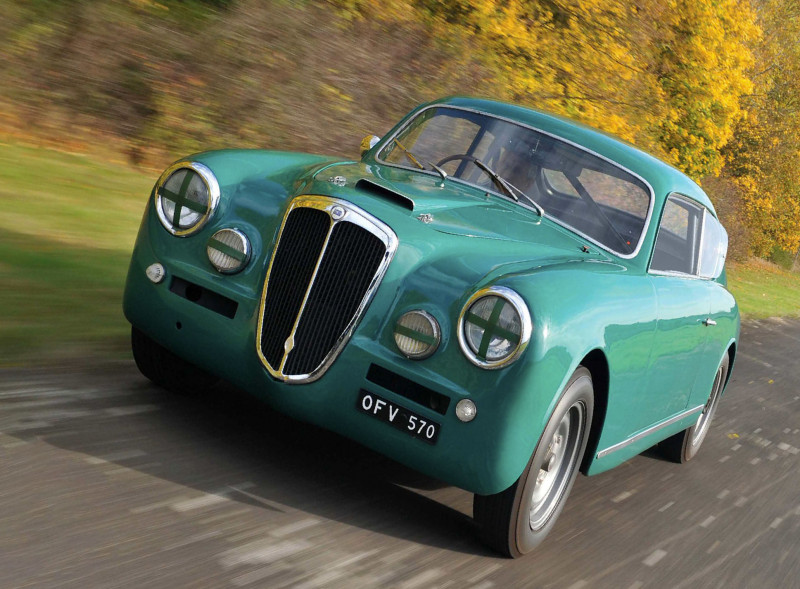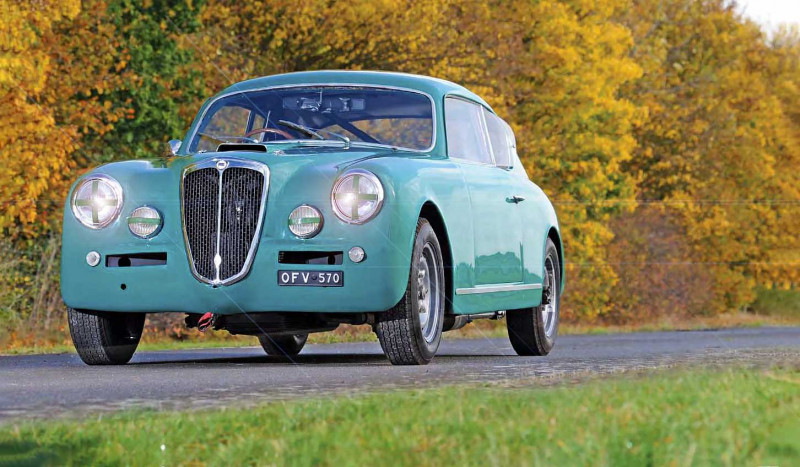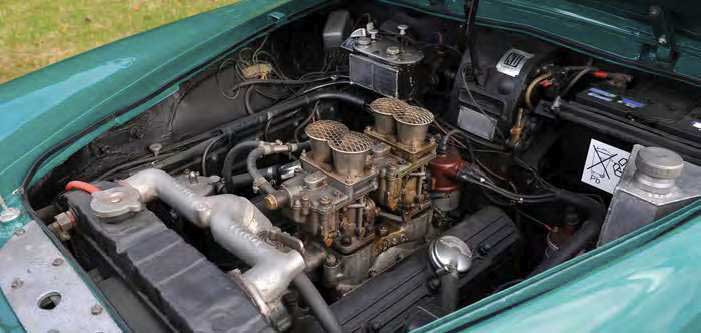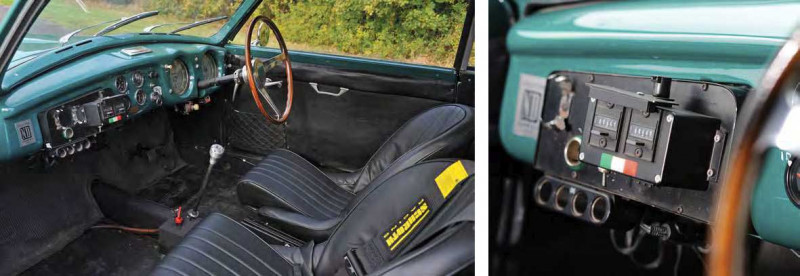1953 Lancia Aurelia B20 GT Series 3 Racer
Lancia’s ground-breaking Aurelia B20 GT was not only an object lesson in elegance but also a superlative tool for racing. That status remains as relevant today as was in 1951.
Racing The ‘Relia
Story by Roberto Giordanelli
Images by Michael Ward
RAVISHING RACER MAGICAL AURELIA B20 GT
The best-looking road racer of all time?
When Lancia launched the Aurelia B20 GT in 1951, it arguably created a whole new genre, since it had conjured up the world’s first post-war car with ‘GT’ (Grand Tourer) in its name. Not only that, the Aurelia debuted the world’s first production V6 engine. At a time when most mainstream manufacturers were producing engines that made around 30hp per litre, Lancia’s V6 doubled that figure. The illustrious Turin brand then spent many years ahead of the game, as the B20 GT stormed early-day mountain rallies and road races, driven by heroes like Ascari and Villoresi. The Aurelia also became the personal transport of the likes of Fangio and Hawthorn.

What you are looking at here with this green car is a vehicle way ahead of its time. The B20’s designer was Francesco de Virgilio, working under the legendary race car creator, engineer and designer, Vittorio Jano. The B20 GT’s advanced mechanical configuration lent itself to motorsport – and continues to do so, often in the possession of erudite aficionados such as Goodwood’s Duke of Richmond. It doesn’t harm its cause that the whole package and styling delivers elegancy.

“This coupe is the perfect choice for the Mille Miglia: spacious and comfortable, whilst delivering good handling”
The 1953 Lancia Aurelia B20 GT Series 3 Racer we have on test is painted in the original green colour it would have been when new. With the Series 3, the all-aluminium V6 motor had grown from 2.0 to 2.5 litres. A rear mounted aluminium transaxle gave this 1100kg car a near-50/50 weight distribution. Its independent rear suspension with inboard rear brakes kept unsprung weight low so that the rear wheels had good traction. Those wheels were originally supplied in metric dimensions, which means that tyres are no longer available, the solution in this case being a two-piece construction made by welding Aurelia centres to Flaminia rims. Historic racing rules stipulate the use of Dunlop crossply tyres designed in the 1950s, which offer little in the way of grip, but a huge amount of predictability and fun.
You will have noticed that this Lancia is right-hand drive, which is its original Italian specification. Some early Ferraris were also right-hand drive, as were many Italian trucks, right up until the 1980s. The reasons are complex because Italy is complex. Italy switched from driving on the left to the right-hand side of the road over a period of about 30 years. Italian regionality has always been deep-seated, with different rules between regions. As you entered each town, there would be a sign advising you on which side of the road that particular municipality preferred you to drive. Don’t laugh! Italy has always been beautifully bonkers, which is why those who don’t live there like it so much. It was not until 1923 that Il Duce Benito Mussolini decreed a nationwide switch to driving on the right.

However, years later, Lancia and Ferrari were still making cars in right-hand drive – right up until the 1950s in fact – because race circuits have mostly right-hand turns and RHD gives advantages in weight distribution. Then there’s the irritation caused by driving off a cliff or bouncing off a rockface. Post- 1923, on Italy’s mountainous terrain and narrow roads, RHD places the driver closer to the edge of the road for better precision driving, be it a plummeting precipice or rigid rockface – hence early road-racers’ and truckers’ fondness for RHD.
Back at our UK test site, the Aurelia’s lightweight monocoque steel body with alloy bonnet, boot and doors supply respectable rigidity in a period when many manufacturers were still using prehistoric ladder-frame chassis or first-generation floppy monocoques. Some early works cars had all-aluminium bodywork and Perspex windows, and tipped the scales at just 900kg. In the case of our test car, there are Perspex windows and the structure is beefed up with the addition of a rear rollcage, moving the GT coupe from four-seater to two-seater status.

During the 1950s, there were period optional extras, which today the FIA sanctions for competition use. Our green car has a Nardi inlet manifold permitting the use of a pair of twin-choke 40DCL downdraught Weber carburettors. It also has a Nardi gearshift system with four-on-the-floor rather than a column change. I see that each of the tubular exhaust manifold downpipes swoop down into three-into-one collectors, which is the latest thinking for race exhausts. Two straight-through silencers deliver a sporty sound that is good for both road and track.

The 2451cc motor’s original 118hp is now more. How much more? At a guess, it’s maybe up to 130hp. Depending on how much money you throw at the Lancia’s 2.5 V6, I suspect it could produce 170-220hp given a racing camshaft and some internal work with stronger and lighter internal components. As a rule of thumb, at 8000rpm, a two-valve-per-cylinder engine can make 100hp per litre, or around 250hp for a 2.5 V6. However, this engine is always kept below 6000rpm. As with most cars of the period, its stroke (85.5mm) is greater than its bore size (78mm).
Therefore, if much higher revs are the goal, it will go bang unless the internals are upgraded. While the original bore/stroke ratio and standard internals hinder it becoming a high-revving screamer, it does deliver useful torque and a linear power band, which is perfect for multi-role uses such as circuit racing, rallying and road events like the Mille Miglia. In fact, this closed coupe is a perfect choice for that 1000-mile event which is held in Italy’s rainy season. The B20’s enormous boot capacity and large rear seat area are ideal for transporting baggage and longdistance kit. The ride is comfortable whilst delivering good handling, despite the absence of anti-roll bars.
Recently fitted period-type seats are more comfortable than race seats, and are race-legal thanks to a line in the FIA Appendix K bible. The car feels so much more modern than its years suggest. It is only at parking speeds that the unassisted steering, even with three-and-a-half turns lock to lock, reminds you that it is over 70 years old.
This car has a sound, documented history and matching numbers, with the original engine safely stored. Between 1990 and 2017, its previous owner, Chris Gawne, completed no fewer than 100 competition events in the car. The current owner, Andrew Davenall, who’s had it since 2017, has raced a few times himself, including in the Fordwater Trophy at the Goodwood Revival. Former F1 driver John Watson MBE was asked which car he would take home from Goodwood’s glittering event, and said: “Oh, the green Aurelia.”
Davenall also shared a race at the 2018 Castle Combe Historic Festival with co-driver Chris Snowdon who is a pro racer, instructor and race engineer and very well known in Alfa Romeo and Sports 2000 racing circles. Inspecting the TSL timing sheets, I can see that with Snowdon at the wheel this green car managed slightly quicker lap times than the well-campaigned and well-prepared red Aurelia of Jason and Louise Kennedy (see separate panel).
I asked Chris his opinions of racing the green car. “It could do with more power, although I could say that about countless cars that I have raced. Castle Combe, with its fast 1.85-mile lap, is a notorious killer of a historic car’s braking system. There are two chicanes plus the tight Quarry Corner. All three require a car to slow very quickly from near its top speed down to a crawl. The Aurelia’s drum brakes must be in perfect working order to achieve this, after which they require checking, manual adjustment or maintenance. As for the all-important handling of the car, it’s great.”
COUNTERPOINT: THE KENNEDYS’ AURELIA B20

Jason and Louise Kennedy bought their Aurelia B20 GT S3 15 years ago. Jason comments: “It was partly as Aurelias are such fabulous looking cars, but also due to their racing pedigree and capacity to cover long distances at speed in great comfort. It is no wonder Aurelias were campaigned so widely in period, from Silverstone, Goodwood, Le Mans, Mille Miglia, Targa Florio, Carrera Panamericana, Monte Carlo Rally, Liège-Rome-Liège, to every other rally and hill climb in Italy. “It can take part in just about every historic racing event you can imagine.
We have been fortunate enough to compete at Goodwood, Le Mans, Silverstone Classic, Monza Historic, Grand Prix De l’Age D’Or at Dijon, Oldtimer GP and the Marathon on the Nordschleife. Our friend Tim used to drive his Aurelia to events as far as Sicily, compete and then drive home, while I know others who have used their Aurelias to compete in events as demanding as the Carrera Panamericana and Peking to Paris.
“Just as in period, our three outright wins on the Modena Cento Ore demonstrate that the Aurelia’s superior handling and impeccable reliability enable it to punch above its weight. But throughout all this, driving the Aurelia is a comfortable and truly magical place to be.”
Still feels modern to drive. Race-legal period-style seats are comfier than outright race items. Nardi manifold and twin Weber carbs boost standard 118hp to perhaps 130hp. Plenty of torque on tap.
TECHNICAL SPECIFICATIONS LANCIA AURELIA B20 GT RACER
- ENGINE: 2451cc V6
- BORE X STROKE: 78mm x 85.5mm
- FUEL SYSTEM: 2 x twin-choke Weber 40DCL carbs
- MAX POWER: 130hp at 5700rpm (est)
- MAX TORQUE: 190Nm (140lb ft) at 3500rpm (est)
- TRANSMISSION: 4-speed manual, rear-wheel drive
- SUSPENSION: Sliding pillar, coil spring (front), semi-trailing arm, coil spring (rear)
- BRAKES: Drums all round, inboard rear
- TYRES: Dunlop Racing 500 L15 CR65 or Avon radial road tyres
- DIMENSIONS: 4369mm (L), 1549mm (W), 1359mm (H)
- WEIGHT: 1100kg (est)
- MAX SPEED: 120mph (est)
- 0-62MPH: 8.0 sec (est)


